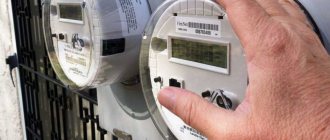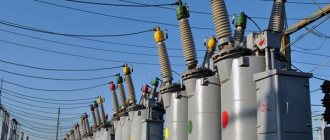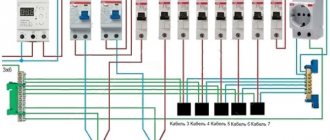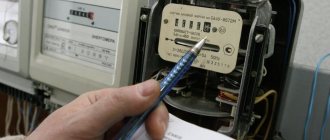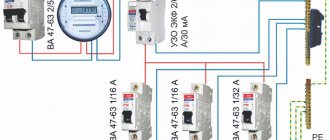When arranging the environment in an individual building, it is difficult to foresee everything at once. After some time, there is a need to increase the electrical load per residential building user. Country home owners experience this problem more often than others.
Any country house needs power in kW Source pokter.ru
How can you increase the permitted kW power of electricity? For a private home, solving the problem of increasing load is quite possible. It will be possible to increase the permitted power of electricity consumed by the owner of a country house if certain conditions are met.
Increasing electricity capacity for private homes
There are 3 options, you can choose one of the following solutions:
- Send an application to the network company.
It sets out a request for additional electricity.
- Formally, “increase” the power consumption.
This can be done through proper load distribution. This will require prioritization skills.
- Install an inverter in the house.
This is special storage type equipment.
Storage type equipment for a private home Source topradar.ru
Controversial situations
The procedure for connecting 15 kW to a private house is standard. Difficulties may arise if the site is located on the border of zones served by two network companies. Choose the company whose poles are located closest to the site.
Failure to meet connection deadlines due to the fault of the servicing power line company is a rare but possible option. During construction, the lack of electricity can lead to additional costs and failure to fulfill obligations with construction participants.
Enter into agreements with contractors, taking into account the possibility of shifting the timing of connecting the facility to the power grid.
Always save contracts and documents with the network company, including issued specifications. This will help you assert your rights in court and recover damages.
Buildings for which the electrical load can be increased
The need to increase electric power capacity may arise for various reasons. More often than others, applications are submitted for such objects as:
- private houses;
- cottages;
- garages;
- residential or non-residential premises in suburban buildings.
In an apartment building, increasing the permissible load for a specific apartment is an almost impossible task. How to increase electricity capacity for the owner of such a home? Let's look at it in this article.
How many kW is needed to heat 1 sq. m?
This is the easiest way - to use plumbing standards, which stipulate that a thermal power of 100 W per hour is needed to heat 1 square meter. m. We must remember that this method is used for rooms with standard height ceilings (2.5-2.7 meters), and the result is somewhat inflated.
Interesting materials:
How to quickly check whether a number is prime or not? How fast do champignons grow? How to quickly defrost minced meat from the freezer? How quickly can I light coals? How to quickly take off from a standstill in a manual car? How to quickly erase a MacBook? How to quickly remove stumps from a site? How to quickly remove an exclamation mark from a photo? How to quickly recover from panic attacks? How to quickly dry varnish without a lamp?
Increasing the electrical load of your home
First, the total load of all electrical appliances used in everyday life is established, that is, add up their calculated capacities. Coefficients are applied to the resulting value and an indicator of the total power consumption is obtained.
Electrical installation work cannot be carried out without first obtaining permits. Any actions with the electrical panel must be coordinated in advance with the relevant structures that supply users with electricity.
How to increase electricity power in a private home? Read in the next section.
Answers from experts
little prince:
So, do you need a device for storing electrical energy from the technical electrical network (batteries)? Or generators with batteries? or filters with generators and batteries? ? It should also be taken into account that in winter, electrical consumption. energy will increase significantly. If you have a project, you should describe it at least a little, otherwise what to start from? In general, what do you need: GENERATOR and BATTERY? Or just a battery with an inverter and a filter. In the latter case, you will end up with a huge installation, unprofitable in terms of maintenance and economically too. It would be easier to use a gas generator.
******:
If we take into account the average load of 3 kW, this is approximately 15 amperes. For example, for a day. It works out. 360 ampere hour. (this is about three KAMAZ batteries) If you make a frequency converter, it will output 220 V. Well, for your 50 kW it’s about 2300 ampere hour. or capacity of 20 KAMAZ batteries. or the capacity of all batteries of one diesel locomotive is 70 cans, the size of each can is 18 liter canisters (although they are alkaline and the size will take half of your country house - I think it’s not realistic and not necessary)
User deleted:
It’s easier to connect a gas generator and turn it on during interruptions and reduce the load
Avotara:
With an average constant load (computer + refrigerator 250 W) and average daily variable load (fluorescent lamp lighting + TV 65 W), 4 batteries of 200 A*h 12 V should be enough for 28 hours
Woviy:
Private house with gas equipment, 4 people + frequent guests, average 250 kW per month, no savings. Delhi for 30 days = 8.3 kW per day. Batteries are not practical, service life + price= very expensive. The cheapest option is El. generator, if possible, connect to domestic gas.
Stages of the procedure
To obtain permits you must:
- Write a statement to the local Electric Networks.
Increasing the kW power to 15 kilowatts for electricity consumption will require obtaining technical conditions for connecting an additional load and other permitting documents.
- Take a technological connection agreement.
In response to the submitted application, the network organization issues electrical documentation: technical specifications (technical conditions), permission to connect additional power to supply the house with electricity. These documents are calculated by specialists from the electric grid company. The applicant is also given a draft agreement for technical connection to the networks; it is signed by both parties after familiarization.
It is important to know! Do not confuse the two agreements: 1) for connection; 2) for power supply. The latter is issued to the applicant at Energosbyt after successful completion of all procedures for increasing power. As evidence of completion of the process, an act will be drawn up, which will become a permitting document (approval of the electric meter for operation).
- Contact a company that develops project documentation.
The property owner needs to review the current documents relating to the electricity supply of his property. All changes provided for in the technical specifications must be completed. But first they must be reflected in the design documentation.
Electrical supply project for a private house Source ehto.ru
- Perform electrical installation work.
It all depends on the requirements specified in the technical specifications. Technological connection, when increasing the permitted power, can be made by both representatives of electrical networks and a specialized electrical installation organization that has SRO approvals.
Based on the results of the work performed, 3 acts are prepared:
- compliance with technical conditions;
- approval of the electric meter for operation;
- on the implementation of technological connection.
It is very difficult and almost impossible for the property owner to deal with these issues independently. For this, many home owners turn to specialized organizations.
- Submit documents to the energy sales company.
Based on 3 acts, energy sales representatives will make adjustments to the electricity supply agreement.
When will the lights be turned on?
So, you have a contract and specifications in your hands. The conditions list the measures that, by completing them, will bring the site in accordance with the requirements of the network company. Usually they are interested in the metering unit and the machines that disconnect the wires in an emergency. As a rule, the box with the meter is installed on a pole (pipe stand) on the outside of the site.
The video below shows an example of performing technical specifications. Pay attention to the budget pipe stand. You can install it yourself.
In winter, connection is possible if the pole and wires are located close to the metering station. When additional wire supports need to be installed, the network company's lead time may be extended to one year. The deadlines for fulfillment of obligations by the parties are specified in the agreement.
Increasing electricity capacity in a private home: when additional demand arises
Cases where there is not enough allocated power occur after:
- repairs associated with redevelopment;
- installation of a “warm floor” connected to electricity;
- expansion of housing area;
- simultaneous use of household appliances.
The most powerful devices:
- electric stove oven;
- washing machine and dishwasher;
- air conditioner;
- TV;
- microwave.
If all devices operate simultaneously, the allocated kW power may not be enough.
Why count so precisely?
We wrote down all the electrical appliances on a piece of paper and went online to look for the consumption of each of them. It is best to do this in online stores, where the power is usually immediately indicated in the characteristics.
And by the way, when you have calculated everything, be sure to add 10-20% for unplanned sources of consumption.
You may say: why take everything into account so thoroughly, since we will never include everything at once?
Now, maybe you won’t, but when the construction problems are behind you, you won’t want to keep in mind the fact that you can’t turn on something while another device is working. Believe me, this is extremely uncomfortable. And when the line is under extreme loads, this is also not good. Can you be sure that in five years you won’t want to have an electrically heated floor?
And if the load at the connection point exceeds the declared one, you may receive a fine. My personal advice: it’s better to inflate this figure... I recommend writing down all consumers with their capacities on a piece of paper and going to the energy sales office with it. They will still double-check you there and try to “squeeze” your needs.
Increasing electrical power in non-residential premises
Typically, commercial real estate operates devices that consume a lot of electricity:
- refrigeration units in production shops;
- air conditioners in offices;
- freezers in retail chains.
Because of this, owners of commercial properties are forced to deal with issues of increasing the permitted load in order to avoid interruptions in the power supply to the facility.
How to increase electricity power in non-residential premises?
The process consists of 4 stages:
Step 1. First, an application is submitted to the power grid organization, drawn up according to a standard template. Attached to it:
- a scan of the lease agreement or certificate of ownership of the property (information from the Unified State Register of Real Estate);
Sample USRN extract for a real estate property Source prodom365.ru
- extracts from the register of the Federal Tax Service for legal entities or individual entrepreneurs;
- scan of the organization's Charter;
- a duplicate of the order for the appointment of a director of the enterprise;
- power of attorney for the owner's representative.
Step 2. Obtaining technical conditions and a connection agreement.
The technical specifications indicate a list of electrical installation work required to be performed by the applicant, as well as by the electrical grid organization.
Step 3. Carrying out the activities provided for by Electric Grids.
The applicant carries out electrical installation work indoors at his own expense. The remaining procedures are carried out by the network company. After completion of the required work, on-site inspections are carried out by representatives of electrical networks. If there are no violations, reports are issued.
Step.4 All changes made to the power plan are included in the current contract.
Within a month after completion of the work and if there are 3 acts, the applicant enters into the contract with the energy supply organization information about increasing the permitted power.
How do you know how much power is allocated?
Those who do not know the amount of permitted power for a house or apartment can use the following ways to obtain information:
- Get a certificate from the energy supply company. It should be taken into account that such a service is considered paid; for example, at Mosenergosbyt you will have to pay from 1.3 to 3.1 thousand rubles for it, depending on the category of the residential property.
- Look for the required parameter in the energy supply contract or technical specifications.
- Obtain information empirically by looking at the parameters of the input protective device. The fact is that in most cases, in addition to its direct functions, it plays the role of a power limiter. To set its maximum value, it is enough to find out the operating current of the machine.
Operating current parameters (marked in red)
The figure shows a diffautomatic machine with an operating current of 32 A (Inom). Therefore, the maximum permissible load power can be calculated using the formula: Pmax = U x Inom x 0.8; where U is the rated network voltage. Therefore, 230 x 32 x 0.8 ≈ 5.5 kW.
Of all the options presented, the most reliable is the first, especially since a certificate will still be needed if you plan to increase the allocated power (it is included in the package of necessary documents).
Calculations based on the operating current of the input circuit breaker should not be trusted too much. Some models of modern electronic meters have a built-in load relay. In such cases, the rated current of the machine may be overestimated.
Documents for increasing the load on an existing facility
Documents for increasing the load on an existing facility
The list of documentation for increasing the electrical load is exactly the same as for a new connection to the electrical grid.
For legal entities, the following must be attached to the application:
- layout of equipment and lighting fixtures;
- scan of the certificate of ownership of the object;
- extract from the Unified State Register of Legal Entities;
- a copy of the charter and constituent documents.
When a third party is entrusted to represent the applicant’s interests, a notarized power of attorney is attached.
Applications of ordinary citizens are supplemented with the following data as defined in the Decree of the Government of the Russian Federation:
- scanned copy of the certificate of ownership (USRN extract);
- copy of the passport;
- layout plan for electrical appliances;
- notification of the absence of emergency automatic devices.
It is important to know! For commercial premises located in a residential building, you must obtain consent from the management company.
What cannot be placed in an apartment building? Source trishurupa.ru
What is needed to increase electricity power in an apartment
Sometimes property owners in an apartment building need to increase the permitted power. Usually this situation appears after installation:
- heated floors connected to electricity;
- air conditioners;
- electric stoves
In a normal situation, one apartment does not consume more than 15 kW of electricity. It is difficult to obtain high permissible power for housing located in an apartment building. It is impossible to provide an electrical load to a specific apartment owner. The legal entity that is the balance holder of the internal electrical network of the entire house must request additional power.
Increasing the permitted power in a parking garage
For this purpose, you need to contact the local Electric Networks with an application. List of required documents:
- scanned copy of the certificate of ownership (USRN extract);
- copy of the owner's passport;
- architectural plan showing the location of the garage;
- scan of the TIN certificate.
Based on the received application, the network organization issues specifications to the applicant that are subject to execution. All work within the garage provided for by the technical conditions is carried out by the owner on his own. Upon completion of all necessary actions, an employee of the electrical network company inspects the metering device. The correspondence of the counter with the specifications and the PUE is established. If there are no violations, 3 acts described earlier are issued. Based on permitting documents, the energy supply company increases the estimated capacity for the garage.
Any garage needs electricity Source russtroys.ru
Receiving and increasing the allocated load up to 15 kW
An applicant who submits an application to connect an authorized power of up to 15 kW, taking into account the already connected load, pays for electrical installation work at a reduced price of 550 rubles including VAT.
The cost of 1 kW is influenced by the following factors:
- the magnitude of the declared load;
- location of the object connected to the network;
- technical resources for accession;
- power supply category.
An application for the issuance of technical specifications for increasing the permitted power to 15 kW at a preferential tariff for previously constructed buildings must be submitted only if it is not possible to prove your right to an additional electrical load.
